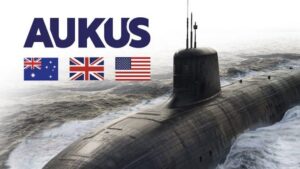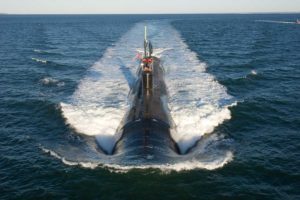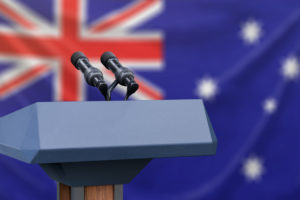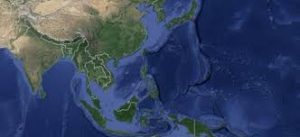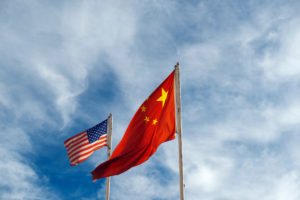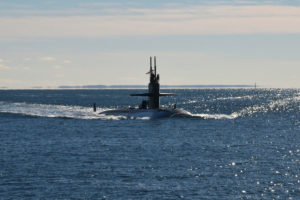In April 2023, the Australian government released its Defence Strategic Review, setting out a vision for reforming the country’s national defence posture. The Review displays Canberra’s recognition that China’s military build-up, assertions of sovereignty in the South China Sea and competition with the US have the potential to threaten Australian regional interests. Quite significantly, it also recommends the adoption of a ‘strategy of denial’, utilising anti-access/area denial (A2/AD) capabilities that would constrain adversary action in Australia’s adjacent geographic spaces.
This comes at an interesting time for the AUKUS trilateral partnership between the US, Australia and the UK. The release of the Review provides AUKUS with a greater rationale (namely, utilising Australia’s relationships with the US and UK to address the challenge of regional tensions with China), but the reference to a strategy of denial also raises a thought-provoking question. As an island state, maritime power is crucial to Australia’s defence; the strategy of denial laid out in the Review will therefore shape this power. Therefore, it is important to ask whether AUKUS provides the type of maritime power that will be needed for this denial strategy.
The matters raised by the Review bring us to a particular conception of maritime power proposed a year earlier by James Heappey, the UK Parliamentary Under-Secretary of State for the Armed Forces, at the First Sea Lord’s Sea Power Conference in May 2022: ‘disruptive’ maritime power projection, a term that seems new but which actually has deeper historical roots. This essay seeks to shine a spotlight on such a conception of maritime power, and whether it is applicable in AUKUS’ case. To that end, the essay subjects the concept to a critical examination, asking whether it is of utility in reference to AUKUS and (more generally) to Australia’s ability to attain a strategy of denial. As argued here, the concept of ‘disruptive’ maritime power is of general utility in understanding what AUKUS seeks to do, but with some caveats: it is not a blueprint that can be readily applied to any situation; nor is it new or unique to the present day. Its underlying essence has been true of war throughout history. To that end, the essay provides a brief overview of AUKUS, then defines maritime and ‘disruptive’ maritime power (with reference to the latter’s drivers), before applying this concept to the AUKUS case to assess its usefulness.
An overview of AUKUS’ key developments
It is necessary to outline what AUKUS entails before discussing whether it represents a disruptive form of maritime power and whether such a concept is of utility. The trilateral partnership between the US, UK and Australia consists of two ‘Pillars’. Pillar I is focused on Australia’s acquisition of a new class of nuclear-powered submarine (the SSN-AUKUS). In addition, the US has signalled its intention to sell Australia three Virginia-class submarines by the early 2030s. This is to act as a stopgap measure until the development of SSN-AUKUS, which will utilise a British design with American technological input. In order for Australia to develop sufficient capacity for the ship-building project, various steps are required, such as information exchange with AUKUS partners; development of workforce expertise; baselining of infrastructure and industrial capabilities; development of constructing and basing facilities; and engagement with the international nuclear non-proliferation regime. This road forward was outlined in the Joint Leaders Statement on AUKUS in March 2023.
The acquisition of the three Virginia-class boats, and over time the development of the new SSN-AUKUS fleet, will significantly enhance Australia’s naval capabilities. At present, the Royal Australian Navy Submarine Service possesses diesel-electric Collins-class boats. Nuclear-powered boats, by contrast, will possess increased speed and endurance. While these vessels would not necessarily be a game-changer in the Indo-Pacific, they would certainly present a greater potential challenge to China. However, AUKUS encompasses more than submarine development. Under Pillar I, AUKUS will see collaboration on enhancing joint capabilities and interoperability. Pillar II of AUKUS focuses on technological capabilities such as artificial intelligence (AI), autonomous systems, other undersea capabilities, cyber and electronic warfare, hypersonic weapons, and more. Taken together, these pillars will entail collaboration on integrating defence and security-related sciences, technologies, industries and supply chains to a deeper extent.
From maritime power to ‘disruptive’ maritime power
If we are to assess the relevance of maritime power and its ‘disruptive’ form to AUKUS, conceptual clarity is needed. In UK doctrine, maritime power is “[…] a measure of the total national engagement with the sea, the capacity to operate there and the ability to exploit it”. It therefore encompasses an actor’s military and civil instruments of power in, from and related to the maritime space. This includes navies, military power exercised by other branches of a state’s armed forces that produce effects in and from the sea, and civilian maritime assets and activities onshore and offshore (merchant shipping, fisheries, offshore resource exploitation, marine scientific activities, marine insurance, shipbuilding, manpower and so on). Thus, maritime power can be understood as what Geoffrey Till has called an ‘input’ – the means needed to exploit the sea. However, Till also stressed that maritime power is more than just a checklist of inputs. The outputs that maritime assets and activities produce are also crucial, i.e. the effects on the behaviour of other actors and the end goals that they attain, whether in the form of increased security and/or prosperity, and/or the denial of these same ends to an adversary.
Traditionally, maritime power consists of the physical and cognitive assets possessed by an actor relating to the sea, from naval forces to maritime communities and their economic activities, and the effects that these assets can produce at different levels (from the tactical to the political). Returning to the aforementioned First Sea Lord’s Conference, Heappey referred to the imperatives for a “more disruptive approach” to maritime power projection. While acknowledging the benefits of large platforms capable of delivering hard power (such as the UK’s carriers and their strike groups), the UK Parliamentary Under-Secretary raised the question as to whether larger ships and submarines are the answer to the challenges faced in a world where missile technology is seemingly advancing, supply chains are contested and resources limited.
Indeed, fears persist around the development of hypersonic weapons by adversary states, though it is worth noting that they are technically challenging to develop and operate. This is not to suggest that there is no threat from adversary hypersonic capabilities whatsoever; it is merely a caution against technological determinism. Nonetheless, as part of a wider A2/AD picture, hypersonic weapons will play a role – whether for kinetic strike or conventional deterrence. Global supply chains, meanwhile, have been squeezed as a result of the war in Ukraine, the lingering impacts of COVID on sourcing, logistics and production, living costs, labour unrest and environmental issues, generating concerns regarding access to resources needed for necessities such as foodstuffs, semiconductor materials and key automotive components, among others.
Heappey emphasised that, although large naval assets are beneficial to the UK for their ability to project hard power at distance, there is also a need for “dispensable, dispersible, autonomous capabilities” that present adversaries with a more difficult challenge. Such assets would give the navy capabilities a “pricklier, more lethal” maritime power projection. As such, the concept of disruptive maritime power has two key characteristics: first, a shift beyond emphasising large platforms for projecting power at and from the sea; and second, presenting adversaries with more difficult “dilemmas”. There are similarities here to the much-older concept of sea denial – utilising force across a spectrum of domains (such as surface, sub-surface, littoral, air, space and cyber) to constrain adversary movements in the maritime space. Indeed, disruptive maritime power should not be seen as something unique to the present. Generating dilemmas for one’s adversaries through dispensable, dispersible and/or non-traditional means is hardly a new phenomenon in maritime war. The approach of using submarine capabilities to threaten an adversary’s critical economic vulnerabilities and/or to constrain the movements of its ships has existed for hundreds of years. Advancements in autonomous aerial platforms and hypersonic weapons should also be seen in the greater historical context of air power’s continual evolution to find new ways to apply pressure to adversaries. Regardless of the roots underpinning the concept, the contemporary security environment drives the perceived need for disruptive maritime power.
One of the greatest concerns at present is revisionist states challenging the rules-based international order, which Western states have relied upon for security and prosperity since the end of the Second World War. In the Indo-Pacific, China has been explicitly identified as a significant threat in the US’ most recent maritime strategy, Advantage at Sea (released in 2020). Beijing is accused of using all instruments at its disposal to “conduct a variety of malign activities incrementally, attempting to achieve their objectives without triggering a military response”. China’s multiple layers of maritime power (the People’s Liberation Army Navy, the Coast Guard and maritime militias), as well as the fears of predatory influence through the Belt and Road Initiative and infrastructure developments, are highlighted. China has also undertaken actions that have challenged aspects of the rules-based international order. This has taken the form of tensions between Beijing’s territorial claims in the South China Sea and international law – most notably the UN Convention on the Law of the Sea (UNCLOS), under which an independent tribunal ruled in favour of the Philippines in 2016, a judgement that Beijing dismissed. The UK government displays a similar perspective. For instance, the 2023 Integrated Review Refresh identifies China’s “epoch-defining challenge” given its growing assertiveness. As already mentioned, the Australian Defence Strategic Review highlights tensions arising from China’s rise as a key regional actor.
There are two other points of note here. First, China has invested heavily in capabilities designed to mitigate the military preponderance of the US and its allies. Much has been made of Beijing’s investment in capabilities for attaining localised advantages, contesting adversaries’ ability to manoeuvre, and inflicting unacceptable costs through degradation and disruption of command, control and logistics. Second, China’s approach to contesting Western adversaries seeks to generate dilemmas. In any outbreak of direct armed hostilities, Beijing would use its capabilities to reduce the impetus of the US and its allies, creating a more favourable situation for achieving its own objectives and terminating conflict on their own terms.
Advantage at Sea identifies other factors that make this situation more precarious for the US and its allies: the backdrop of continuing technological advancement in fields such as AI, autonomous systems, quantum computing and more, which are expected to improve situational awareness, decision-making speed and the ability to deal with greater volumes of data; and shrinking defence industrial bases and budget pressures, which will affect the resources available to meet the task of defence. It is this context that Heappey appeared to have in mind when he used the concept of disruptive maritime power projection. This is quite heavily driven by the security preoccupations of the West, such as concerns over the military modernisation, ambitions and actions of China. However, two questions emerge: first, whether AUKUS will produce a disruptive form of maritime power; and second, whether disruptive maritime power is a useful concept for attaining an Australian strategy of denial.
AUKUS as a form of ‘disruptive’ maritime power
Returning to AUKUS, the fusion of capability developments ranging from nuclear-propelled submarines to other weapons and systems generates a noteworthy picture. If disruptive maritime power is about moving beyond large platforms and placing further emphasis on alternate capabilities, then AUKUS certainly appears to be an illustrative case. Its emphasis is not just on large submarine platforms; it is also on dispersible and autonomous capabilities for generating a “pricklier, more lethal” maritime power. From a maritime point of view, the undersea capabilities in Pillar II are a particularly interesting aspect. Namely, this concerns the development of autonomous underwater vehicles, a potential force multiplier for the AUKUS navies. For Australia the development of autonomous platforms represents an advancement in capability, as autonomous vehicles would offer a covert means for monitoring maritime traffic in their adjacent waterways. AUKUS has also made steps towards the development of airborne drones with swarming capabilities. If integrated into a holistic package alongside crewed platforms and other Pillar II capabilities (such as hypersonic weapons and AI-enabled systems), autonomous technologies could offer Australia a “larger and more pervasive naval capability”.
The combination of Pillar I and II capability enhancements lends itself well to the strategy of denial envisaged by the Australian Defence Strategic Review. Such tools might serve to contain China’s Indo-Pacific ambitions, showing that Beijing’s own maritime capabilities are as vulnerable to degradation as those of its rivals. Improving Australian capabilities plus the opportunity to interoperate with the US and the UK signals to China that, just as Beijing has the means to contest enemy movements and inflict politically/strategically costly damage in any conflict scenario, so too does AUKUS. This may make Beijing more reluctant to engage in overt armed hostilities towards neighbours such as Taiwan, given the risks of escalation. China cannot predict exactly how the US would respond to an attack on Taiwan – but AUKUS adds another layer to the matter. However, deepening security ties between Washington, Canberra and London could see the latter two being drawn into regional conflict (especially with US and UK submarines using Australian ports).
Conclusions
The AUKUS example therefore fits the disruptive maritime power concept, suggesting that there is usefulness to the latter in a general sense (i.e. as a conceptual tool for reflecting on alternate means of challenging adversaries’ ability to project power at and from the sea). However, there are limits to its utility. ‘Disruptive’ maritime power is a broad umbrella term, encompassing many approaches to contesting adversary movements at sea. It is not a rigid blueprint for navies to follow; what it means in practice will be context dependent. AUKUS is just one way in which disruptive maritime power is manifesting, but it is an example unique to circumstances in the Indo-Pacific. Thus, disruptive maritime power is analogous to other broad conceptual terms in naval thought, such as A2/AD. It is a concept born from the current strategic preoccupations of the AUKUS states, such as the threat posed by China, and thus care must be taken when applying it elsewhere. Neither should disruptive maritime power be seen as something unique to the present; as already established, it bears similarities to older naval concepts such as sea denial.
The point of these examples is not to suggest that disruptive maritime power is devoid of conceptual utility. As a conceptual tool it can encourage thinking about how new capabilities could be used to complement traditional assets, to deliver greater lethality, and to constrain/deter an adversary by presenting more difficult dilemmas. However, the key point is that this should not be seen as something unique to today. Disruptive maritime power is the latest expression of an enduring reality: the imperative to find ways to achieve strategic advantage through deterrence, dislocation and dilemma rather than through large and costly decisive engagements. AUKUS illustrates this, bringing together like-minded partners to improve a package of capabilities which will enhance the ability to conduct a strategy of denial by raising the costs for any adversary aggression.
Moreover, AUKUS remains an unfolding process. Its effect on adversary behaviour will need to be continually monitored. However, what has been shown is that disruptive maritime power is a useful concept when understanding what AUKUS seeks to do and how it can achieve Australia’s desired strategy of denial. It is hoped that this essay will initiate a greater conversation on the subject; at present, the concept of disruptive maritime power itself is still young, even if its underlying essence is nothing new. Thus, this essay has sought to begin expanding the discussion on the matter, to prompt a larger debate on its usefulness in naval and strategic thought.
